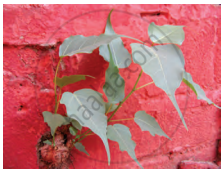Advertisements
Advertisements
प्रश्न
Look at some plants and trees around you. Imagine how deep and spread out the roots of these are?
उत्तर
The roots of plants are two inches to ten inches deep, while the roots of a tree are five feet to ten feet deep. Also, the roots of some trees go as deep as 50 feet into the earth.
APPEARS IN
संबंधित प्रश्न
The stick which was stuck in the ground fell very easily. It was difficult to pull out a small grass. Why?
Which of the plants around you need regular watering?
- What will happen, if nobody gives water to these plants?
Abdul realised that he never watered the huge neem tree. “Where did it get its water from?” he thought.
Abdul wondered whether radish was a root. Why did he think so?
Look at the pictures below and find out which of these vegetables are roots.
 |
 |
 |
 |
 |
 |
 |
 |
 |
 |
Nowadays Abdul keeps thinking about all kinds of plants that he sees.

Abdul saw a plant growing out of a wall in school. He wondered-
- How deep must the roots of this plant be going?
- How do the roots get water?
- How big will this plant grow?
- What will happen to the wall?
- Can you give the name of the plant in the picture?
Which are the oldest trees in your area?
- Find out from your elders how old the trees are?
- Name animals who live on this tree.
- Have you ever seen any big tree that had fallen down? What did you think when you saw it?
Get together with 3-4 of your friends – From the list of things given, decide who will bring which thing.
A transparent glass tumbler or bottle with a wide mouth, rubber band or thread, some seeds of moong, wheat, bajra, mustard, channa (chickpeas) or rajma (red beans) and a wad of cotton wool.
Each group will work with only one kind of seed. Soak a few seeds (5-6) overnight in a bowl full of water. Take the wad of cotton wool and wet it. Put it on the mouth of the tumbler. Tie it tight to the mouth with a rubber band or thread. Remove soaked seeds from the water and place them on the cotton wool. You will have to take care that the cotton wool does not dry. Observe the changes that take place for the next 10 to 12 days. Did you observe the seedlings come out of the seeds? Draw the picture of the seedling as it looks on the fourth and the eighth day.
Write in your notebook
- What difference did you observe in the seeds after soaking? Compare with dry seeds and write.
- What do you think would happen if the cotton wool had been left dry?
- In which direction did the roots grow? And the stem?
- How big did the plant grow in the cotton wool?
- Did small plants come out from all the seeds?
- What is the colour of the roots?
- Did you see any hair on the roots?
- Try and pull out one little plant from the cotton wool. Were you able to pull it out? Why?
- Did you see how the roots grip the cotton wool? Do you think that the roots hold the soil in the same way?
- Also, look at the plants grown by your friends.
Arif and Roopali did the below activity. They saw the seedlings grow. When asked – what are the things that grow? They had very different ideas about things that grow.
Arif made a list of the following – Leaves, munna, bud, puppy, nails, fish.
Roopali’s list had – Moon, tree, I, hair, watermelon, mosquito, crow.
- What do you think? Which of these things listed by Arif and Roopali grow?
- Why don’t you make your own list of things that grow? Your list can include the names of things that are in Arif’s and Roopali’s list.
Think about yourself – in what ways have you changed over a period of time? Have you grown in any way? For example –
- Has your height increased? How much taller have you grown in the last one year?
- Imagine that you had never cut your nails! Draw a picture of your fingers in the notebook to show how they would have looked.
- What other part of your body (some people cut it regularly) keeps growing?
